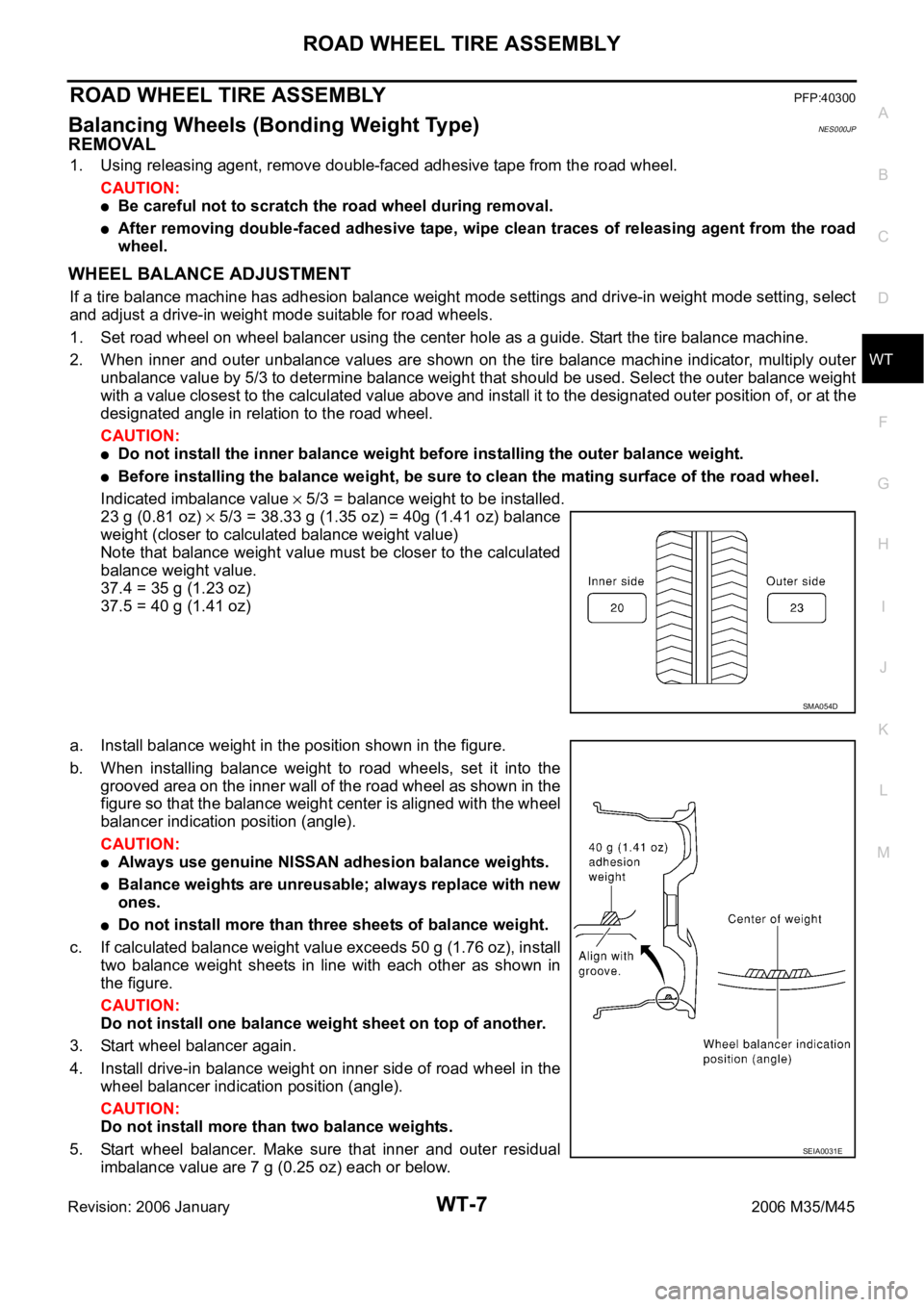tire type INFINITI M35 2006 Factory Service Manual
[x] Cancel search | Manufacturer: INFINITI, Model Year: 2006, Model line: M35, Model: INFINITI M35 2006Pages: 5621, PDF Size: 65.56 MB
Page 5364 of 5621

PRECAUTIONS
SRS-3
C
D
E
F
G
I
J
K
L
MA
B
SRS
Revision: 2006 January2006 M35/M45
PRECAUTIONSPFP:00001
Precautions for Supplemental Restraint System (SRS) “AIR BAG” and “SEAT
BELT PRE-TENSIONER”
NHS0008O
The Supplemental Restraint System such as “AIR BAG” and “SEAT BELT PRE-TENSIONER”, used along
with a front seat belt, helps to reduce the risk or severity of injury to the driver and front passenger for certain
types of collision. This system includes seat belt switch inputs and dual stage front air bag modules. The SRS
system uses the seat belt switches to determine the front air bag deployment, and may only deploy one front
air bag, depending on the severity of a collision and whether the front occupants are belted or unbelted.
Information necessary to service the system safely is included in the SRS and SB section of this Service Man-
ual.
WAR NING :
To avoid rendering the SRS inoperative, which could increase the risk of personal injury or death
in the event of a collision which would result in air bag inflation, all maintenance must be per-
formed by an authorized NISSAN/INFINITI dealer.
Improper maintenance, including incorrect removal and installation of the SRS, can lead to per-
sonal injury caused by unintentional activation of the system. For removal of Spiral Cable and Air
Bag Module, see the SRS section.
Do not use electrical test equipment on any circuit related to the SRS unless instructed to in this
Service Manual. SRS wiring harnesses can be identified by yellow and/or orange harnesses or
harness connectors.
Precautions for SRS “AIR BAG” and “SEAT BELT PRE-TENSIONER” ServiceNHS0008P
Do not use electrical test equipment to check SRS circuits unless instructed to in this Service Manual.
Before servicing the SRS, turn ignition switch OFF, disconnect both battery cables and wait at least 3 min-
utes.
For approximately 3 minutes after the cables are removed, it is still possible for the air bag and seat belt
pre-tensioner to deploy. Therefore, do not work on any SRS connectors or wires until at least 3 minutes
have passed.
Diagnosis sensor unit must always be installed with their arrow marks “” pointing towards the front of the
vehicle for proper operation. Also check diagnosis sensor unit for cracks, deformities or rust before instal-
lation and replace as required.
The spiral cable must be aligned with the neutral position since its rotations are limited. Do not turn steer-
ing wheel and column after removal of steering gear.
Handle air bag module carefully. Always place driver and front passenger air bag modules with the pad
side facing upward and seat mounted front side air bag module standing with the stud bolt side facing
down.
Conduct self-diagnosis to check entire SRS for proper function after replacing any components.
After air bag inflates, the front instrument panel assembly should be replaced if damaged.
Always replace instrument panel pad following front passenger air bag deployment.
Occupant Classification System PrecautionNHS0008Q
Replace occupant classification system control unit and passenger front seat cushion as an assembly.
Refer to SE-165, "
Passenger's Seat Components" .
Page 5526 of 5621

WT-1
ROAD WHEELS & TIRES
E SUSPENSION
CONTENTS
C
D
F
G
H
I
J
K
L
M
SECTION WT
A
B
WT
Revision: 2006 January2006 M35/M45
ROAD WHEELS & TIRES
PRECAUTIONS .......................................................... 3
Precautions .............................................................. 3
PREPARATION ........................................................... 4
Special Service Tools [SST] ..................................... 4
Commercial Service Tools ........................................ 4
NOISE, VIBRATION AND HARSHNESS (NVH)
TROUBLESHOOTING ................................................ 5
NVH Troubleshooting Chart ..................................... 5
ROAD WHEEL ............................................................ 6
Inspection ................................................................. 6
ALUMINUM WHEEL ............................................. 6
STEEL WHEEL ..................................................... 6
ROAD WHEEL TIRE ASSEMBLY .............................. 7
Balancing Wheels (Bonding Weight Type) ............... 7
REMOVAL ........................................................
..... 7
WHEEL BALANCE ADJUSTMENT ...................... 7
Rotation .................................................................... 8
LOW TIRE PRESSURE WARNING SYSTEM ............ 9
System Components ................................................ 9
System Description .................................................. 9
TRANSMITTER ..................................................... 9
RECEIVER .......................................................
... 10
LOW TIRE PRESSURE WARNING CONTROL
UNIT .................................................................... 10
LOW TIRE PRESSURE WARNING LAMP ......... 10
DISPLAY UNIT ..................................................... 11
CAN COMMUNICATION .......................................... 12
System Description ................................................ 12
TROUBLE DIAGNOSES .......................................... 13
How to Perform Trouble Diagnoses ....................... 13
BASIC CONCEPT ............................................... 13
Schematic .............................................................. 14
Wiring Diagram — T/WARN — .............................. 15
Control Unit Input/Output Signal Standard ............. 18
ID Registration Procedure ...................................... 19
ID REGISTRATION WITH ACTIVATION TOOL ... 19
ID REGISTRATION WITHOUT ACTIVATION
TOOL .................................................................. 20
Transmitter Wake Up Operation ............................. 21
WITH TRANSMITTER ACTIVATION TOOL ........ 21CONSULT-II Function (AIR PRESSURE MONI-
TOR) ....................................................................... 21
FUNCTION .......................................................
... 21
CONSULT-II SETTING PROCEDURE ................ 21
WORK SUPPORT MODE ................................... 22
SELF-DIAG RESULT MODE ............................... 22
DATA MONITOR MODE ...................................... 23
ACTIVE TEST MODE ......................................... 23
LOW TIRE PRESSURE WARNING CONTROL
UNIT PART NUMBER ......................................... 24
Diagnosis Procedure with Warning Lamp Function
(Without CONSULT-II) ............................................ 24
DESCRIPTION .................................................... 24
FUNCTION .......................................................
... 24
LOW TIRE PRESSURE WARNING LAMP DIAG-
NOSTIC CHART .................................................. 24
How to Perform Trouble Diagnosis for Quick and
Accurate Repair ...................................................... 26
INTRODUCTION ................................................. 26
WORK FLOW ...................................................... 26
Preliminary Check .................................................. 27
Trouble Diagnosis Chart ......................................... 28
SELF-DIAGNOSIS .............................................. 28
DIAGNOSIS CHART BY SYMPTOM .................. 29
TROUBLE DIAGNOSIS FOR SELF-DIAGNOSTIC
ITEMS ........................................................................ 30
Inspection 1: Transmitter no Data ........................... 30
MALFUNCTION CODE NO. 21, 22, 23, 24 ......... 30
Inspection 2: Receiver Data Error .......................... 31
MALFUNCTION CODE NO. 25, 26, 27, 28 ......... 31
Inspection 3: Transmitter Pressure Data Error ....... 32
MALFUNCTION CODE NO. 35, 36, 37, 38 ......... 32
Inspection 4: Transmitter Function Code Error ....... 32
MALFUNCTION CODE NO. 41, 42, 43, 44 ......... 32
Inspection 5: Transmitter Battery Voltage Low ....... 33
MALFUNCTION CODE NO. 45, 46, 47, 48 ......... 33
Inspection 6: Receiver ID No Registration .............. 33
MALFUNCTION CODE NO. 51 ........................... 33
Inspection 7: Vehicle Speed Signal ........................ 34
Page 5532 of 5621

ROAD WHEEL TIRE ASSEMBLY
WT-7
C
D
F
G
H
I
J
K
L
MA
B
WT
Revision: 2006 January2006 M35/M45
ROAD WHEEL TIRE ASSEMBLYPFP:40300
Balancing Wheels (Bonding Weight Type)NES000JP
REMOVAL
1. Using releasing agent, remove double-faced adhesive tape from the road wheel.
CAUTION:
Be careful not to scratch the road wheel during removal.
After removing double-faced adhesive tape, wipe clean traces of releasing agent from the road
wheel.
WHEEL BALANCE ADJUSTMENT
If a tire balance machine has adhesion balance weight mode settings and drive-in weight mode setting, select
and adjust a drive-in weight mode suitable for road wheels.
1. Set road wheel on wheel balancer using the center hole as a guide. Start the tire balance machine.
2. When inner and outer unbalance values are shown on the tire balance machine indicator, multiply outer
unbalance value by 5/3 to determine balance weight that should be used. Select the outer balance weight
with a value closest to the calculated value above and install it to the designated outer position of, or at the
designated angle in relation to the road wheel.
CAUTION:
Do not install the inner balance weight before installing the outer balance weight.
Before installing the balance weight, be sure to clean the mating surface of the road wheel.
Indicated imbalance value
5/3 = balance weight to be installed.
23 g (0.81 oz)
5/3 = 38.33 g (1.35 oz) = 40g (1.41 oz) balance
weight (closer to calculated balance weight value)
Note that balance weight value must be closer to the calculated
balance weight value.
37.4 = 35 g (1.23 oz)
37.5 = 40 g (1.41 oz)
a. Install balance weight in the position shown in the figure.
b. When installing balance weight to road wheels, set it into the
grooved area on the inner wall of the road wheel as shown in the
figure so that the balance weight center is aligned with the wheel
balancer indication position (angle).
CAUTION:
Always use genuine NISSAN adhesion balance weights.
Balance weights are unreusable; always replace with new
ones.
Do not install more than three sheets of balance weight.
c. If calculated balance weight value exceeds 50 g (1.76 oz), install
two balance weight sheets in line with each other as shown in
the figure.
CAUTION:
Do not install one balance weight sheet on top of another.
3. Start wheel balancer again.
4. Install drive-in balance weight on inner side of road wheel in the
wheel balancer indication position (angle).
CAUTION:
Do not install more than two balance weights.
5. Start wheel balancer. Make sure that inner and outer residual
imbalance value are 7 g (0.25 oz) each or below.
SMA054D
SEIA0031E
Page 5533 of 5621

WT-8
ROAD WHEEL TIRE ASSEMBLY
Revision: 2006 January2006 M35/M45
If either residual imbalance value exceeds 7 g (0.25 oz), repeat installation procedures.
RotationNES000JQ
Follow the maintenance schedule for tire rotation service intervals. Refer to MA-7, "PERIODIC MAINTE-
NANCE" .
Do not include the T-type spare tire when rotating the tires.
CAUTION:
When installing wheels, tighten them diagonally by divid-
ing the work two to three times in order to prevent the
wheels from developing any distortion.
Be careful not to tighten wheel nut at torque exceeding
the criteria for preventing strain of disc rotor.
Maximum allowable unbalanceDynamic (At rim flange) Less than 7 g (0.25 oz) (one side)
Static (At flange) Less than 14 g (0.49 oz)
Tightening torque
of wheel nut: 108 Nꞏm (11 kg-m, 80 ft-lb)
SMA829C